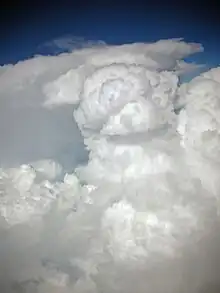Cloud species are a set of fourteen terms used to describe the shape and structure of clouds. Each one has its name abbreviated to a three letter term.[1] [2] [3]

Cumulus congestus clouds in the foreground.
| Species | Abbreviation | Description | Genera |
|---|---|---|---|
| Calvus | cal | Tops of clouds lose hard, rough appearance and become smooth | Cb |
| Capillatus | cap | Tops of clouds become distinctly fibrous or striated. Cirrus clouds are often in appearance | Cb |
| Castellanus | cas | Distinct turrets rising from a large base or line of cloud | Sc, Ac, Cc |
| Congestus | con | Great vertical height much larger than the base, shows vigorous growth with cauliflower like tops | Cu |
| Fibratus | fib | Fibrous appearance, with straight or uniform curves and no distinct hooks | Ci, Cs |
| Floccus | flo | Individual tufts of clouds with ragged bases and often with noticeable virga | Ac, Cc, Ci |
| Fractus | fra | Broken cloud with ragged bases and edges | Cu, St |
| Humilis | hum | Cloud with limited vertical height with a length much bigger than their height | Cu |
| Lenticularis | len | Lens or almond shaped clouds that are stationary in the sky | Sc, Ac, Cc |
| Mediocris | med | Clouds of moderate height that are around equal height and length, growing upwards | Cu |
| Nebulosus | neb | Featureless sheet of cloud with no structure | St, Cs |
| Spissatus | spi | Dense cloud appearing lighter shade of grey when viewed toward the sun | Ci |
| Stratiformis | str | Cloud in an extensive sheet or layer | Sc, Ac, Cc |
| Uncinus | unc | Distinctly hooked usually without a visible head | Ci |
References
See also
This article is issued from Wikipedia. The text is licensed under Creative Commons - Attribution - Sharealike. Additional terms may apply for the media files.